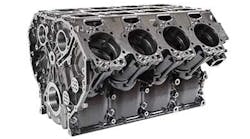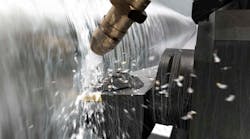New workholding systems ditch hydraulics and better regulate clamping forces.
Electricity heats the T-Vise's polymer-filled actuater, which, in turn, operates a piston and die spring to clamp parts.
Temperature-controlled, water-based cutting fluid heats the polymer and regulates clamping forces of the TCAM-Powered coolant clamping system.
TCAM's multiple-fixture coolant clamping system provides 2,500 lb of automated clamping force, and each of its modules accomodates two workpieces. Shops can also implement modules as
When heated, polymer grows with tremendous force. This plastic-like sub-stance has generated up to 400,000 psi in lab settings. With this kind of potential, it is no surprise that one company decided to harness the power of polymers and incorporate them into a line of workholding systems.
TCAM Power Workholding LLC of Mentor, Ohio, has developed two workholding systems that use thermo-polymer power to clamp workpieces. The first, called T-Vise, is electrically powered by common wall outlets, while the other, the TCAM-Powered coolant clamping system, uses hot water for the most part. Basically, these power sources heat the polymer that, in turn, produces clamping force. While both systems eliminate the use of hydraulics, their main advantage is better control of clamping forces.
Controlling force
At the heart of TCAM's system is an actuator, which contains a polymer chamber encased in a thick-walled pressure vessel. The polymer used actuates in 1 sec and has a lifespan of 750,000 cycles. The system is rebuildable and takes 20 min to replace. Each system contains about 0.6 in. 3 of polymer, which melts at about 130°.
Added slip agents let the polymer move through the system's passages more easily. The polymer is incompressible, which means that when a load is applied, it does not shrink down. According to Edward Schneider, president of TCAM, "It has no sponginess — once the actuator clamps a vise or other workholding device shut, there is no give." But the key to regulating an actuator's force and speed is through varying the heating and cooling of the polymer.
For the most part, the company presets the speed of both its T-Vise and coolant clamping systems. "In the world of actuators, solenoid devices operate as fast as 50 msec," says Schneider, "and shops are somewhat conditioned to that speed. But the truth is that manually clamping a vise takes between 3 and 5 sec. On the other hand, hydraulically powered systems, for example, operate so fast that they pose a possible safety hazard and require guarding and other precautions."
TCAM wants its systems safe and free of pinch hazards to the operator, so it sets its systems at a closing speed of 1 sec. According to Schneider, this is more than enough time for an operator to react to a closing vice.
Each of the two systems cools the polymer differently. Cooling not only releases parts, but also controls clamping forces. TVises use what is known as passive cooling, while the coolant clamping system uses active cooling.
TCAM's passive cooling lets heat dissipate through the vise's surroundings. On the T-Vise there is an aluminum housing that bolts to a mill's bed or another aluminum plate, both of which channel away heat. This setup is well suited for applications that require high clamping force over long periods of time because a lot of heat goes into the unit's surroundings. And in milling applications using water-based cutting fluid, the liquid actually assists in dissipating heat.
As part of TCAM's active-cooling setup, there is a hot bath, cold bath, and temperature-control bath. The hot bath, at about 180°, closes the clamp, and the 70° cold bath opens it.
After the clamp closes, the system switches to the temperature-control bath, which regulates clamping force. At 180°, this bath maintains a force of 2,500 lb, and at 140°, clamp force is 1,200 lb.
However, if a shop is working with ceramic parts, clamping force should be around 800 lb. This is not a problem for TCAM's system because the temperature-control bath can be set to produce as little as 135 lb of clamping force. Being able to set clamping force means parts are not distorted due to over or under clamping.
Whether to use passive or active cooling depends on the application and duty cycle. If a shop wants to run many fast actuations, and it is dry machining, an active cooling system is recommended.
A die spring in the T-Vise transfers polymer pressure to the jaws. The vise produces 2,900 lb of clamping force and holds a set clamping force to within 50 lb of pressure every time.
Manual part-clamping forces, on the other hand, can vary between 800 and 1,500 lb, depending on the operator, says Schneider. With this in mind, he asks, "What good is a machine tool capable of holding tolerances to within 0.0001 in. if the workholding is distorting parts as much 0.005 in.?"
Without hydraulics
A workholding system without hydraulics means no more pumps, fittings, valves, and other associated plumbing. Most importantly, it means no more hydraulic fluid leaking into cutting fluid and eventually becoming airborne via the machining process.
According to Schneider, 94% of all workholding is still manual, even though machine tools are high tech. And the reason, he has found, is that hydraulics are a hassle, and more shops would rather deal with manually operating their workholding systems instead. In addition, he says, hydraulics just don't fit with robotic systems.
T-Vises use no fluids, so they can be set up away from the machine tool. And, they will connect to a machine's CNC, so the opening and closing actions are in the part program itself.
The TCAM coolant clamping system, on the other hand, is a somewhat dedicated, multiple-fixture system that does use fluid. This fluid heats the polymer but does not harm machines or humans because it's a water-based cutting fluid.
The system uses all low-pressure plumbing, only 40 psi, which is controlled by a thermostat, so there are rarely high-pressure leaks. And in the event of a leak, usually caused by an external accident like a cutter severing a line, the fluid readily and safely mixes with the machine's cutting fluid.










